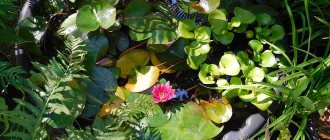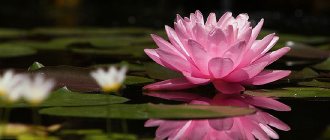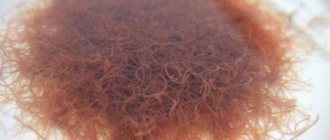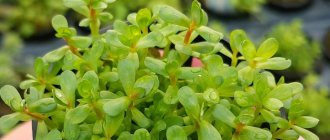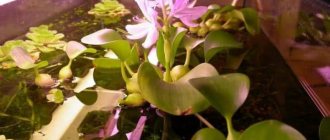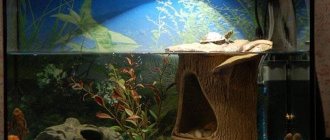Pistia is the only representative of this family; it is a perennial plant that floats on the water surface. Its natural habitat is tropical waters of both the eastern and western hemispheres (in America, Africa, and some parts of Asia). The natural form is considered a weed that infests rice crops, also taro, and interferes with navigation. The plant has several common names: it is known as "water lettuce", "floating lettuce" (cabbage), even water rose.
Due to its beneficial properties, it is also used in the treatment of dysentery, skin diseases, it is fed to livestock, pigs, used as a useful fertilizer, detergent, etc.
Pistia attracts aquarists with its very attractive and unusual appearance, unpretentiousness, and ability to filter and purify water from heavy metal salts. Fry, small fish, and spawning individuals love to hide in its roots; turtles (red-eared turtles, for example) love to feast on them.
Description of pistia
The plant has a short straight stem, thick spongy leaves, ovoid (sometimes wedge-shaped) in shape, gathering into fairly large rosettes, reminiscent of a cabbage head or bunches of lettuce, with a diameter of 10 to 45 cm and reaching a height of 15-30 cm. The color is bluish-green. , saturated.
Towards the base, the leaves often narrow, the veins are located parallel along the length of the leaf, they are slightly pressed into the leaf, which is why the leaves seem slightly “corrugated”. On the entire surface of the leaves you can see short gray hairs that prevent the leaves from getting wet.
Pistia has a good root system, consisting of roots up to 30 cm.
It usually blooms when it reaches a rosette size of approximately 10 cm in diameter. The nature of the inflorescence is in the form of a spadix, 1 cm in size, the male flowers are small, do not have a decorative appearance, fragrant, white, in quantities from 2 to 8 pieces. At the bottom there is one female flower with numerous ovules.
The fruit is a green berry, inside of which there are brownish cylindrical seeds measuring 1 mm in size. The plant has the ability to self-pollinate: when the anthers open, pollen falls onto the stigmas.
The growth and development of pistia occurs in several cycles: with increasing daylight hours, its faster growth begins with the appearance of new strong leaves and the formation of lateral shoots. Active growing season usually lasts up to several months.
Species features
This aquatic plant has a small number of species and varieties:
| Known species | Characteristic |
| This floating variety is distinguished by the presence of small leaves with a bluish color. It is small in size, making it more suitable for improving miniature reservoirs. |
| It has the smallest dimensions, leaves with particularly corrugated ends, with a leaf diameter of 7 to 10 cm. |
| This type of pistia is characterized by interesting patterns in the form of spots on the leaf blades and creamy-yellow stripes that make up peculiar patterns and designs. Unfavorable living conditions lead to the disappearance of the characteristic color and the appearance of a monochromatic color. It is recommended to remove such leaves. |
All these varieties require the same care, i.e. no special specific conditions are needed.
Interesting features of pistia: it can hold on even in strong currents, without moving at all and sticking its roots upstream.
Possible difficulties
With improper care or insufficient lighting, difficulties may arise with growing pistia. So, with a lack of sunlight, the leaves of water cabbage become small. There is less and less foliage on the rosette. In addition, water lettuce stops blooming, which also indicates a low amount of light.
If you keep the plant in cool temperatures or poor-quality dirty water, the pistia quickly withers and stops growing. The growth of shrubs is also reduced.
If the pistia is rarely fed, it stops increasing in size. The foliage on the bush becomes faded and thin. The plant stops blooming. When placing the aquarium in a sunny place, the water lettuce quickly returns to normal.
Aquarium conditions
The plant has gained great popularity due to its rapid growth and lack of special care. However, the most important of the basic requirements are the following:
- intense and sufficiently strong lighting, the presence of daylight hours of at least 12 hours a day: only well-lit plants fully open their heads of cabbage, and close back at night;
- the location of the light sources is not too low to avoid burns to the leaves: the height of fluorescent lamps is at least 5 cm, and incandescent lamps are at least 10-15 cm (LED lamps can be close, because they do not heat up);
- maintaining temperature parameters to avoid reduction in leaf size;
- mandatory water changes within a quarter of the volume weekly;
- maintaining medium hardness, since too hard water slows down its growth and development;
- the composition of the soil does not affect the well-being of pistia at all, because it is a completely floating plant;
- aquarium inhabitants should be indifferent to pistia, otherwise eating the roots will interfere with its normal development.
Partially covering the container with a lid will provide the necessary humidity for further flowering of the pistia.
During the dormant period, you can slightly reduce the lighting and change the water much less often.
Existing types
Varieties of Pistia teloresidae:
- salad with ruffles – Ruffled water lettuce;
- Jurassic salad – Jurassic water lettuce;
- splash – Polka dot plant or hypoestes.
Ruffle lettuce grows more wavy leaves and they are not as large as other varieties. Ruffled water lettuce is suitable for small ponds. Jurassic water lettuce is a species that grows to the size of a plate. Lettuce grows no slower than similar species. Polka dot plant is a variegated form that is hard to find.
Secrets of reproduction
The main method is only vegetative propagation through tendrils with daughter rosettes, which should be separated after 2-3 leaves have formed on them. If the maintenance regime is observed, pistia reproduces quite intensively on its own, “waking up” after winter and intensively sending out shoots.
If such “babies” appear in winter, then it is better to place them on peat moss and cover them with a piece of glass for storage.
Growing from seeds is also possible, but is not used at all due to the simplicity of the vegetative method. This method remains relevant only in natural conditions, where all this happens independently with the help of water currents.
Winter dormancy period
Winter is a difficult test for pistia.
It is necessary to prepare the plant for dormancy and create conditions favorable for “hibernation”:
- from the beginning of autumn, the water temperature begins to slowly decrease to +17°C;
- reduce the duration of illumination by 2 times;
- do not apply fertilizers;
- water is renewed less frequently.
If these simple conditions are met, water cabbage will grow and develop beautifully after wintering. As lighting increases in winter, the aquarium plant begins to shrink and degenerate.
What's the best way to plant?
After purchasing a planting specimen, do not forget to carry out preliminary preventive measures:
- Thoroughly rinse the root system to prevent the transfer of unnecessary pathogens of various diseases into your aquarium.
- To treat and disinfect plants, it is undesirable to use strong fungicidal and insecticidal substances that are harmful to most inhabitants, but it is better to use a weak solution of potassium permanganate (or hydrogen peroxide).
- Afterwards, they need to be washed again with water.
Experts recommend keeping the planting material in quarantine for a month beforehand, and then placing it in an aquarium.
Secrets of success
To preserve the decorative appearance of the plant, high air humidity in the room with the aquarium is needed.
Under favorable conditions, the degree of pubescence of the plant increases, and the pubescence becomes brighter.
It is important to properly organize the wintering of Pistia. For winter storage, small rosettes of leaves are left, which are collected in August-September. Large sockets are not stored due to their susceptibility to rotting.
Outdoor Pistias are placed for the winter in an aquarium or a lighted pond in a winter garden with a water temperature of +16°C. They can also overwinter in a chamber with high humidity and an air temperature of +12‒14°C, on a cushion of damp sphagnum moss.
Why isn't it growing?
Sometimes the pistia may begin to turn yellow, rot and stop growing. What's wrong here? Let's look at the main reasons for this behavior:
| Causes | Violations |
| Light duration | An insufficient amount of light slows down photosynthesis in the leaves and in the plant as a whole; it first becomes smaller and sinks into the water. |
| Incorrect humidity in the container | Lack of partial covering of the tank surface with a lid. |
| Lack of nutrition and fertilizing | Slowing down of full growth. |
| Presence of drugs | Leaving the pistia in the same aquarium while treating the fish (it is better to remove it for a while). |
| Presence of pistia root “eaters” in the tank | Proper coexistence is not provided (presence of decorative snails). |
Care
Water lettuce takes root well in almost all artificial conditions, however, for a decorative appearance, it is necessary to provide the bush with special living conditions. This way the shrub will delight you with its beauty for a long time.
The main condition for keeping pistia is the sunny side. The plant requires a lot of light so that the leaves receive enough vitamins. In addition, water lettuce stops growing in size if it lacks sunlight. The peculiarity of the plant is that it grows poorly under artificial light lamps, so you need to place an aquarium or container with the plant only on the south or southeast side.
In the case of growing water cabbage under an artificial lamp, it must be taken into account that the bush can get burned from the light, since it is located close to the source. Thus, it is necessary to place the lamp so that it is at least 30 cm from the edge of the socket.
Pistia does not require special care, but for full growth it is necessary to place the plant in aquariums and ponds with a large number of living creatures. Thus, the water cabbage will receive a sufficient amount of nutrients and perform its function - water purification.
Water cabbage must be kept in high humidity, so for optimal growth, the shrub is placed in a closed aquarium, which constantly contains condensation. Aquariums in which pistia swims should be covered with thick glass so as not to prevent sunlight from reaching the foliage. If the leaves dry out, the plant quickly withers and dies.
The aquatic bush grows quite quickly, so to maintain the optimal diameter of the rosette, it is necessary to regularly remove side shoots and tendrils. Otherwise, the main shrub will be replaced by young wild pistias, which will lead to the extinction of the individual. In addition, young individuals take nutrients from the central plant. The plant stops growing and blooming, gradually withering.
Since the roots float freely under water and absorb excess nitrates, they are washed regularly. To do this, take the water salad out of the water and carefully wash it under warm running water. If the plant grew in a container with a large number of spawning fish, the roots should not be washed, since the fish lay eggs in the roots of the water cabbage.
Feeding and fertilizers
The state of the root system of a given plant will itself tell you about the need for additional feeding: the longer and more powerful the roots, the more they lack nutrition, and therefore they stretch out in search of it. Conversely, ordinary, inconspicuous roots indicate wealth and a favorable position.
The active growing season requires fertilizing during the spring and summer. Liquid complex fertilizers for aquarium plants, containing iron in the amount of 1.5-2 grams for every 100 liters of aquarium water (Flora-1 and other special fertilizers), are better suited for this. At this time, it is advisable to change part of the water more often and try to increase the number of fish, which are a source of natural nitrogen compounds. During dormancy, no fertilizing is applied at all.
The role of pistia in your aquarium
This aquatic plant not only performs decorative functions, but also has many useful properties: it actively absorbs and consumes organic matter dissolved in water, and is an indispensable biological filter. In addition, it is capable of accumulating harmful salts of heavy metals and unnecessary components in its leaves and tissues.
The lower leaves and dense root system are an indispensable refuge for fry and small fish.
Undoubtedly, this beauty, unusual for our latitudes, occupies one of the most worthy places in the design and normal functioning of aquariums, surprises with its shape and appearance, and captivates with its unpretentiousness and ease of reproduction.

